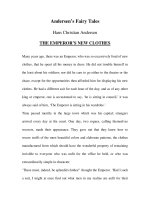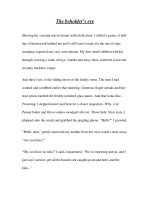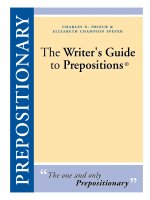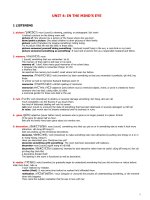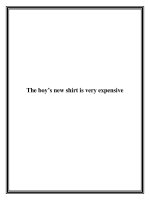Graphic Organizers - The Writer’s Widgets
Bạn đang xem bản rút gọn của tài liệu. Xem và tải ngay bản đầy đủ của tài liệu tại đây (99.75 KB, 10 trang )
okay,
we’ve learned that the essay
test is not going away any time soon
and that essay tests are not a bad thing
because they help us become more
effective writers and communicators.
But since anxiety is the detour that
blocks the road to proficient writing,
how will knowing that more writing
means better writing help conquer
anxiety and writer’s block when you
face the dreaded essay test? And the
higher the test-taking stakes—passing,
promotion, graduation—the greater
the writing roadblock. Even compe-
tent writers in the throes of test anxi-
ety flounder and write essays devoid of
graphic organizers
9
two
Graphic
Organizers:
The Writer’s Widgets
chapter
organization, and consequently lose out on organizational points. If you
haven’t already learned how your essays are scored, you need a quick lesson
in rubrics.
get the point! know how
you’ll be scored
R
UBRIC IS THE
fancy word for rule.
Rubrics, then, are the rules by which
you are scored. There are many varia-
tions of rubrics, and largely the form
they take depends on the state in which you live. You will learn more about
the rules of writing in later chapters. For now, here’s a brief look at them:
■
Idea and Content
■
Organization
■
Voice
■
Word Choice
■
Sentence Fluency
■
Conventions/Mechanics
visual
writing
10
Anxiety is the detour that blocks the
road to proficient writing. And the
higher the test-taking stakes, the
greater the writing roadblock.
graphic organizers
11
The critical minutes you spend organizing your topic through visual writ-
ing ensures you an essay with organizational integrity. That organization will
help you earn most or all of the points for the Organization rubric. But the
benefits of visual writing don’t stop there. The logical flow established by
your essay’s visual map helps you see and communicate your central idea
more clearly. As a result, you will write a more focused essay that helps you
earn more Content and Idea points. Visual maps free you from “Where do I
begin?” and “How do I end?” jitters, giving you the freedom and the power
to devote more time to your word choice and your sentence structure, earn-
ing you the points earmarked for Writing Style.
(While visual maps help you with what you write, and how you mechanical-
ly write—your spelling, capitalization, punctuation, etc.—determines the num-
ber of Mechanics/Conventions points you earn.
the art of visual writing
The word essay is derived from the Latin and
French words that mean “to attempt” or
“trial.” How appropriate. An essay is very
much like a trial. And you are the defendant!
Your writing skills are the defense that deter-
mines the verdict. How will you defend your-
self? It’s up to you.
When you are taking an essay test, you are
your sole defense. You are not going to have
your teacher or this book around to help you.
So you must practice visual writing to learn the
art of organization. And it is an art.
Visual Writing is designed to help you prac-
tice. By reading each chapter and completing
each writing activity, you will learn how to
write better essays. You will also become a
better writer and communicator who knows
how to create order out of the seeming clut-
ter and chaos surrounding your ideas, opin-
ions, and knowledge.
visual
writing
12
An essay is very much like a
trial. And you are the defen-
dant! Your writing skills are
the defense that determines
the verdict. Will you be found
guilty or innocent?
the nature of the beast called the essay test
They’re out there. Essay Tests. Waiting to get
you if you’re not prepared for them. But
knowledge is power. The more you know
about essay tests, the more you’ll be ready for
them. There are basically four kinds of writing
that spawn those monstrous essay tests. Here’s
a quick review:
the simple truth about the
four kinds of writing
■
Descriptive writing tests ask you to describe something. Depending on
the essay’s topic—often called a prompt—you might be asked to describe
something or someone real, like a planet or a person. You might have to
describe something or someone imaginary, a UFO, or an extraterrestrial.
The focus of descriptive writing: Effective usage of imagery and
sensory details.
■
Narrative writing tests ask you to tell a story. You might be asked to
write the story behind a personal experience, or construct a fictional
story using your own imagination with guidance from the prompt.
The focus of narrative writing: Effective storytelling with atten-
tion to characterization, setting, and plot development.
■
Expository writing tests ask you to inform your reader about a specif-
ic topic. Expository essays challenge you to use knowledge you have ac-
quired—via school or life lessons—or there could be certain information
included in the test question that you must use as support in your essay.
The focus of expository writing: Skillful presentation of infor-
mation on a specific subject or topic.
■
Persuasive writing tests ask you to persuade your reader to agree with
your opinion on a particular subject or topic. Formats required vary
from paragraphs to letters, both informal and formal.
The focus of persuasive writing: Clear, effective argument using
logic and reasoning.
graphic organizers
13
essay tests

